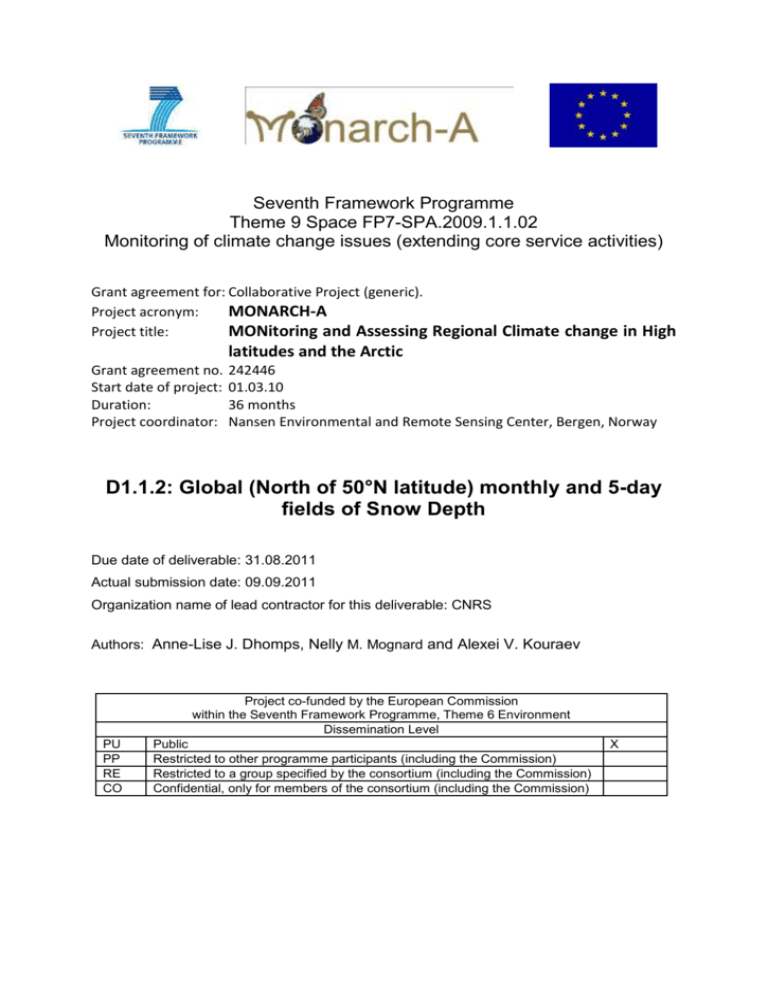
Seventh Framework Programme
Theme 9 Space FP7-SPA.2009.1.1.02
Monitoring of climate change issues (extending core service activities)
Grant agreement for: Collaborative Project (generic).
Project acronym:
MONARCH-A
Project title:
MONitoring and Assessing Regional Climate change in High
latitudes and the Arctic
Grant agreement no.
Start date of project:
Duration:
Project coordinator:
242446
01.03.10
36 months
Nansen Environmental and Remote Sensing Center, Bergen, Norway
D1.1.2: Global (North of 50°N latitude) monthly and 5-day
fields of Snow Depth
Due date of deliverable: 31.08.2011
Actual submission date: 09.09.2011
Organization name of lead contractor for this deliverable: CNRS
Authors: Anne-Lise J. Dhomps, Nelly M. Mognard and Alexei V. Kouraev
Project co-funded by the European Commission
within the Seventh Framework Programme, Theme 6 Environment
Dissemination Level
PU
PP
RE
CO
Public
Restricted to other programme participants (including the Commission)
Restricted to a group specified by the consortium (including the Commission)
Confidential, only for members of the consortium (including the Commission)
X
MONARCH-A
MONitoring and Assessing Regional Climate change in
High latitudes and the Arctic
Grant agreement n° 242446
ISSUE
01
533563432
DATE
07/09/2011 Report
CHANGE RECORDS
Ref: D.1.1.2
Date: 16/02/2016
Issue: 1
AUTHOR
A.-L. Dhomps
Page: 2/13
MONARCH-A
MONitoring and Assessing Regional Climate change in
High latitudes and the Arctic
Grant agreement n° 242446
Ref: D.1.1.2
Date: 16/02/2016
Issue: 1
SUMMARY
The aim of this paper is to provide a description of monthly and 5-days fields of Snow Depth provided
as deliverables 1.1.2. This dataset is a contribution to the Work Package 1.1 "The decadal snow
dynamics and their consequences for GHGs and climate".
Snow depths are calculated with satellite brightness temperature, ground temperature and surface air
temperature. Brightness temperatures come from the passive microwave SSM/I (Special Sensor
Microwave/Imager) on board the DMSP. Ground temperatures are from ISBA and surface air
temperature from NCEP reanalysis.
Monthly and 5-days fields of Snow Depth are available from 1988 to 2010.
533563432
Page: 3/13
MONARCH-A
MONitoring and Assessing Regional Climate change in
High latitudes and the Arctic
Grant agreement n° 242446
Ref: D.1.1.2
Date: 16/02/2016
Issue: 1
MONARCH-A CONSORTIUM
Participant no.
Participant organisation name
Short name
Country
1 (Coordinator)
Nansen Environmental and Remote Sensing Center
NERSC
NO
2
The University of Sheffield
USFD
UK
3
Universität Hamburg
UHAM
NO
4
Centre National de la Recherche Scientifique
CNRS
FR
5
Scientific
foundation
Nansen
International NIERSC
Environmental and Remote Sensing Center
RU
6
Universitetet i Bergen
UiB
NO
7
Danmarks Tekniske Universitet
DTU
DK
8
Institut Francais de Recherche pour l'Exploitation de la IFREMER
Mer
FR
No part of this work may be reproduced or used in any form or by any means (graphic, electronic, or
mechanical including photocopying, recording, taping, or information storage and retrieval systems)
without the written permission of the copyright owner(s) in accordance with the terms of the
MONARCH-A Consortium Agreement (EC Grant Agreement 242446).
All rights reserved.
This document may change without notice.
533563432
Page: 4/13
MONARCH-A
MONitoring and Assessing Regional Climate change in
High latitudes and the Arctic
Grant agreement n° 242446
Ref: D.1.1.2
Date: 16/02/2016
Issue: 1
Table of Contents
Table of Contents .................................................................................................................................... 5
1
Introduction ..................................................................................................................................... 6
2
Sources data .................................................................................................................................... 7
3
2.1
Brigthness Temperature .......................................................................................................... 7
2.2
Air Temperature ...................................................................................................................... 7
2.3
Ground Temperature .............................................................................................................. 7
Datasets ........................................................................................................................................... 8
3.1
Equations ................................................................................................................................. 8
3.2
Calculated datasets ................................................................................................................. 8
3.3
Deliverables ............................................................................................................................. 9
4
Snow depth maps .......................................................................................................................... 10
5
References ..................................................................................................................................... 13
List of Figures
Figure 1: Few Snow Depth pentads from October the 18th to June the 24th in 2008. ........................ 10
Figure 2: Snow Depth winter monthly fields in 2008 ............................................................................ 11
Figure 3: Snow Depth spring monthly fields in 2008 ............................................................................ 12
List of Tables
Table 1: List of pentads ........................................................................................................................... 9
533563432
Page: 5/13
MONARCH-A
MONitoring and Assessing Regional Climate change in
High latitudes and the Arctic
Grant agreement n° 242446
Ref: D.1.1.2
Date: 16/02/2016
Issue: 1
1 Introduction
The aim of this paper is to provide a description of monthly and 5-days fields of Snow Depth (SD)
provided as deliverables 1.1.2. This data are a contribution to the Work Package 1.1 "The decadal
snow dynamics and their consequences for GHGs and climate".
SD are “observed” fields. They are calculated with satellite brightness temperature, ground
temperature and surface air temperature.
533563432
Page: 6/13
MONARCH-A
MONitoring and Assessing Regional Climate change in
High latitudes and the Arctic
Grant agreement n° 242446
Ref: D.1.1.2
Date: 16/02/2016
Issue: 1
2 Sources data
2.1 Brigthness Temperature
We have used passive microwave data set from the SSM/I (Special Sensor Microwave/Imager)
instrument onboard the DMSP (Defense Meteorological Satellite Program) series (since 1987). These
radiometers with incidence angle from 50.2 to 52.8 degrees provided measurements of brightness
temperature at different frequencies and at different (vertical or horizontal) polarizations. We have
used the data from the 19 GHz and 37 GHz channels at horizontal polarization. The National Snow
and Ice Data Center (NSIDC, www.nsidc.org) provides the SSM/I data mapped to the Equal Area (625
km² resolution) SSM/I Earth Grid (EASE-Grid) projection. An overview of the EASE-Grid projection can
be found at the http://nsidc.org/data/ease/, and more detailed information at the
http://nsidc.org/data/ease/ease grid.html. We have used data in the global projection (EASE-ML
grid), that has 1383 pixels in longitude, and 586 values in latitude. Corresponding latitude and
longitude for this EASE-Grid are provided by NSIDC.
In order to perform the processing only on land, we used a mask provide by NSIDC. To minimize the
effects of ice and snow melting, only night brightness temperatures were used (thus affecting the
choice of ascending or descending passes).
The initial data were averaged to obtain the 73 pentad (5 days) mean values in order to get
continuous spatial coverage.
2.2 Air Temperature
For the air temperature, the National Center for Environmental Prediction (NCEP) daily global
reanalysis has been used. They are available on http://www.esrl.noaa.gov/psd/cgibin/dbsearch/DBSearch.pl?Dataset=NCEP+Reanalysis+Daily+Averages+Surface+Level&Variable=Air+Temperature&
group=0&submit=Search. Daily fields are available and they are on a 2.5° regular grid.
The NCEP air temperatures have been interpolated to the EASE-Grid and averaged into pentads.
2.3 Ground Temperature
To estimate the temperature at the base of the snowpack, the ground temperature simulated by the
Interaction between the Soil-Biosphere-Atmosphere (ISBA) LSS are used (Boone et al. [2006]). Daily
1° temperatures fields have been interpolated to the EASE-Grid and averaged to create climatology
of 73 pentads fields over the 1983-1994 period.
533563432
Page: 7/13
MONARCH-A
MONitoring and Assessing Regional Climate change in
High latitudes and the Arctic
Grant agreement n° 242446
Ref: D.1.1.2
Date: 16/02/2016
Issue: 1
3 Datasets
3.1 Equations
SD are calculated as describe in Biancamaria et al. [2008]. It results from the combinaison of a
dynamic algorithm (Mognard & Josberger, [2002] and Josberger & Mognard, [2002]) and a static
Algorithm developed by Chang et al. (1987). The dynamic algorithm is defined with:
TGI is the Thermal Gradient Index which represent the effect of the bulk temperature gradient
through the snowpack,
Tg is the Ground temperature,
Ta is the Air Surface Temperature.
SG is the Spectral Gradient as defined by Josberger and Mognard [2002].
SD is the snow depth,
is the slope of the linear relation between SG and TGI determined with ETAC multiyear average
(Foster and Davy [1988]).
3.2 Calculated datasets
SD have been calculated for all pentads (1 to 73) from 1988 to 2010. Pentads are calculated in
hydrological years: pentad 1 of 1988 starts at the end of September 1987. Monthly fields have also
been calculated over the entire period. They are on the EASE-ML Grid, and above 50°N.
533563432
Page: 8/13
MONARCH-A
MONitoring and Assessing Regional Climate change in
High latitudes and the Arctic
Grant agreement n° 242446
Ref: D.1.1.2
Date: 16/02/2016
Issue: 1
Table 1: List of pentads
We observed some gaps during the first years of the period, mostly on North America. They have to
be investigated further. Gaps are also present in 1994 and 1995. According to NSIDC, during 1994,
substantial amounts of swath data over Alaska and the Canadian Prairies are missing beginning early
in 1994 until May 1995. During this period, the data tape recorder on the DMSP-F11 failed. As a
result, it was necessary to download data to ground stations more frequently than usual. Data
download and acquisition could not occur simultaneously, consequently data gaps exist in the EASEGrid data for Alaska and the Canadian Prairies from early 1994 until data acquisition by the DMSPF13 SSM/I began in May 1995.
3.3 Deliverables
SD are in little endian binary files. Format is integer on 16 bits, and array of 1383 lines by 70 rows and
unit is millimeter. Non-defined values (no brightness temperature) are set to -1.
Snow Depth (SD) file names are:
sd average monthmm yyyy.bin
sd boreal yyyy ppp.bin
with mm=month, yyyy=year and ppp=pentad.
NSIDC mask is in file Ml loci land50 coast0km.1383x586.bin. Latitude and longitude for EASE-Grid are
provided by NSIDC in files MLLATLSB MLLONLSB respectively.
533563432
Page: 9/13
MONARCH-A
MONitoring and Assessing Regional Climate change in
High latitudes and the Arctic
Grant agreement n° 242446
Ref: D.1.1.2
Date: 16/02/2016
Issue: 1
4 Snow depth maps
Figure 1: Few Snow Depth pentads from October the 18th to June the 24th in 2008.
We can observe the raise of the snow depth between the 18th of October 2007 (pentad 05) to the
26th of January 2008 (pentad 25), and then the thawing from the 16th of March (pentad 35) to the
24th of June (pentad 55). January is the most snow-covered month. We can observe some geographic
influence in snow depth with more than 50 cm of snow in Quebec and West of the Rocky Mountains
for North America, and in the Eastern Eurasia, the Central Russian Plateau and in Kamchatka for
533563432
Page: 10/13
MONARCH-A
MONitoring and Assessing Regional Climate change in
High latitudes and the Arctic
Grant agreement n° 242446
Ref: D.1.1.2
Date: 16/02/2016
Issue: 1
Eurasia. Contrary, in the North-West Canadian Territories, the Ob river basin and the Lena river basin
show small content in snow with value lower than 10 cm.
Figure 2: Snow Depth winter monthly fields in 2008
533563432
Page: 11/13
MONARCH-A
MONitoring and Assessing Regional Climate change in
High latitudes and the Arctic
Grant agreement n° 242446
Ref: D.1.1.2
Date: 16/02/2016
Issue: 1
Figure 3: Snow Depth spring monthly fields in 2008
Month fields illustrated the snow accumulation and melting as much as the pentads showed above.
It would be interesting to study inter-annual variability.
533563432
Page: 12/13
MONARCH-A
MONitoring and Assessing Regional Climate change in
High latitudes and the Arctic
Grant agreement n° 242446
Ref: D.1.1.2
Date: 16/02/2016
Issue: 1
5 References
Biancamaria, S., N. Mognard, A. Boone, M. Grippa, A. Josberger, 2008, “A satellite snow multi-year
average derived from SSM/I for the high latitude regions”, Remote Sensing of Environment, vol. 112,
2447-2568.
Boone, A., N. Mognard, B. Decharme, H. Douville, M. Grippa, K. Kerrigan, 2006, “The impact of
simulated soil temperatures on the estimation of snow depth over Siberia from SSM/I compared to a
multi-model climatology”, Remote Sensing of Environment ,vol. 101, 482-494.
Chang, A. T. C., J. L. Foster, D. K. Hall, 1987, “Nimbus-7 SMMR derived global snow cover
parameters”, Annals of Glaciology, 9, 39-44.
Foster, D.J. and R.D. Davy, 1988, “Global Snow Depth Multi-Year Average”, USAFETAC/TN-88/006.
Illinois: Scott Air Force Base. 48 pp.
Grippa, M., N. Mognard, T. Le Toan, E.G Josberger, 2004, “Siberia snow depth climatology derived
from SSM/I data using a combined dynamic and static algorithm”, Remote Sensing of Environment,
vol. 93, 30-41.
Josberger, E.G. and N. Mognard, 2002, “A passive microwave snow depth algorithm with a proxy for
snow metamorphism”, Hydrological Processes, vol. 16, 15557-1586. doi:10.1002/hyp.1020.
Mognard, N. and E.G. Josberger, 2002, “Northern Great Plains 1996/97 seasonal evolution of
snowpack parameters from satellite passive-microwave measurements”, Annals of Glaciology, vol.
34, 15-23.
END OF DOCUMENT
533563432
Page: 13/13









